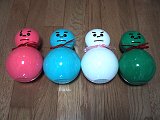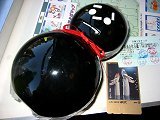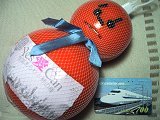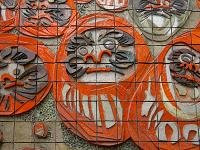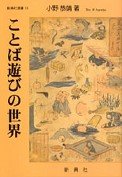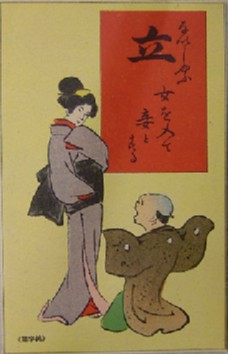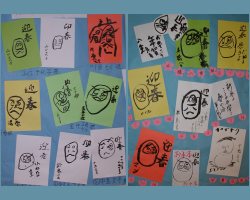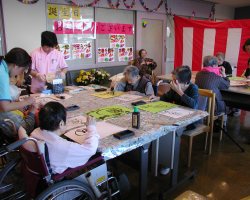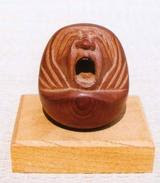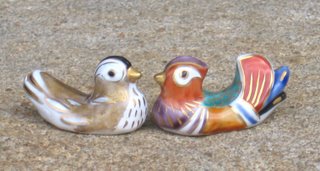. Districts of Edo 江戸の町 .
Setomono, 瀬戸物 see below
. Legends about pottery .
:::::::::::::::::::::::::::::::::::::::::::::::::::::::::::::::::::::::::::::::::::::::::::::::::::::
Yakimono 焼物 / Setomono 瀬戸物 pottery, crockery
. Yakimono, pottery and Haiku .
.......................................................................
達磨 Daruma in and on pottery
Japanese Pottery!
The oldest pottery in the world and in the long history of its development there are so many styles and areas involved, it is easy to loose track.
Talking about Japanese Pottery and Daruma san, I make the distinction between Daruma as a decorative figure or statue (okimono 置物), Daruma painted on a piece of pottery for use, for example a teacup, a soy sauce poorer or an oil dish. In this field we find Daruma almost everywhere! I will cover that in the separate stories.
And finally pottery items for use in the form of Daruma, for example incense burners, toothpick holders and the like. This also calls for different stories. Many pottery centers have some special type of Daruma objects, so I will cover the Pottery of Arita, Bizen, Kutani, Oribe etc. in extra stories.
There might be more in time.
. My ALBUM - Pottery .
. My ALBUM - Kutani 九谷焼 Pottery .
Yakimono - Culture Sketches

. Join the Yakimono Friends on Facebook ! .
:::::::::::::::::::::::::::::::::::::::::::::::::::::::::::::::::::::::::::::::::::::::::::::::::::::::::::::::::::::::::::
Modern Japanese Ceramics:
Pathways of Innovation & Tradition
by Anneliese Crueger (Author), Wulf Crueger (Author), Saeko Ito (Author)

For more than 30 years, Dr. Anneliese and Dr. Wulf Crueger—guided by Saeko Itô—have devoted themselves to studying, understanding, and collecting Japanese ceramics. Today, they share the rich fruits of their knowledge with this lavishly illustrated volume based on their own collection. The equivalent of Roberts Museum Guide, devotees of beautiful ceramics can pick it up and use it to select and visit potters as they undertake an artistic tour of the country.
Organized geographically, it goes from kiln to kiln—which in Japan may refer to a lone site or an entire ceramics region that contains hundreds of workshops. Along the way, they outline the history, development, and unique stylistic characteristics of each area’s work, and the traditions that inspired it.
- source : www.amazon.com
:::::::::::::::::::::::::::::::::::::::::::::::::::::::::::::::::::::::::::::::::::::::::::::::::::::::::::::::::::::::::::
..... Akahadayaki 赤膚焼 Akahada pottery "red skin" Nara
..... Akazu-yaki 赤津焼 Akazu pottery (Akatsu) Aichi
..... Aritayaki, Arita-yaki 有田焼 Pottery from Arita
..... Awata-yaki / Awada-yaki 粟田焼 Awata ware Kyoto
..... Bizen Pottery 備前焼 Bizenyaki - Okayama
..... Hajiki ware 土師器 and 埴輪 Haniwa
..... Hasami-yaki 波佐見焼 Hasami creamics - Nagasaki
..... Igayaki, Iga-Yaki 伊賀焼 Iga pottery, Iga ware - Mie
..... Kameyama yaki 亀山焼 Kameyama Pottery
- Nagasaki yaki 長崎焼 Nagasaki Pottery
..... Karatsuyaki 唐津焼 Pottery from Karatsu
..... Kumamoto 熊本県 pottery . - Shodai yaki, Amakusa yaki, Koda yaki
..... Kumurayaki, Kumura Yaki 久村焼 Kumura Pottery - Shimane
Kuromutayaki, Kuromuta yaki 黒牟田焼 - Saga - Maruta Masami .
..... Kutaniyaki <> Pottery from Kutani 九谷焼
..... Mikawachi yaki 三川内焼 Mikawachi pottery - Nagasaki
..... Mishimayaki 三島焼 Pottery from Mishima
..... Mumyoi-yaki 無名異焼 Mumyoi ceramics - Sado, Niigata
..... Nishikimatsu 錦松 Potter
........ Odayaki 小田陶器の白磁 white pottery from Oda
Oda pottery was founded in 1921, in the production area of Minoyaki, Mizunami-shi, Gifu Prefecture.
In the Mizunami area in the eastern part of Gifu Prefecture, together with close by Tajimi City and Toki City, the area flourished as the production centre of Minoyaki, it is also called "Japan's pottery capital" because of its wide variety of materials, designs and technologies and it has supported Japanese ceramics culture ever since.
..... Oribeyaki Pottery in the Oribe Tradition 織部焼
..... Ontayaki 小鹿田焼 Ontayaki from Sarayama
........ Oyodayaki 大淀焼 Oyoda
-------- Matsubayashi Genei (松林玄衛) of Yoshino, Nara Prefecture.
..... Rakuzan-yaki 楽山焼 Ehime
..... Satsuma Ware 薩摩焼
..... Seto 瀬戸 - Aichi
..... Shinoyaki 志野焼 Shino Pottery
..... Sodeshi 袖師窯 Sodeshi-gama Pottery - Shimane

..... Sumida Pottery 隅田焼 Vase with Daruma
..... Tobe-yaki 砥部焼 Tobe ware, pottery Ehime
..... Tokoname Pottery 常滑焼
Yonezawa yaki, Okitama, Yonezawa city 米沢焼
..... Yonezawa yaki - youtube
..... Yonezawa-yaki Pottery Narushima-gama
.................................................................................
..... Gabi in Takamatsu - Daruma Hunting
:::::::::::::::::::::::::::::::::::::::::::::::::::::::::::::::::::::::::::::::::::::::::::::::::::::::::::::::::::::::::::

- shared by Robert Yellin - facebook - 2015
:::::::::::::::::::::::::::::::::::::::::::::::::::::::::::::::::::::::::::::::::::::::::::::::::::::::::::::::::::::::::::

source : facebook
- quote
Kintsugi (金継ぎ) (Japanese: golden joinery) or
Kintsukuroi (金繕い) (Japanese: golden repair)
is the Japanese art of fixing broken pottery with lacquer resin dusted or mixed with powdered gold, silver, or platinum a method similar to the maki-e technique. As a philosophy it speaks to breakage and repair becoming part of the history of an object, rather than something to disguise.
© More in the WIKIPEDIA !
:::::::::::::::::::::::::::::::::::::::::::::::::::::::::::::::::::::::::::::::::::::::::::::::::::::
Vase from the Heikichi Kiln of Hirashimizu
Yamagata prefecture
The pattern is engraved in a kind of scrafitto by etching the image through the slip.
平清水焼の花瓶
「作者 平吉窯四代目 . 安倍宗太郎」



Photo from my friend Ishino
widest diameter 18cm / hight 25.5cm
This kind of pottery has a history of more than 200 years. Now there are six kilns that produce it.
平清水焼き Japanese Reference
Hirashimizu, to the south of Yamagata city is a renowned pottery producing area. It is said that at its peak there were some 20 producers in the area. This number has now dwindled to six which are enjoying the recent boom in ceramics. The peach Celadon style whereby the iron particles protrude through the celadon glaze giving the pottery a peach-skin effect is particularly well known. Pottery lessons and tours of the buildings where the potters sit at their wheels can be arranged by the Shichiemon, Bun'emon and Heikichi potters.
... www.yamagatakanko.com/
MORE
. Daruma from Hirashimizu 平清水だるま
:::::::::::::::::::::::::::::::::::::::::::::::::::::::::::::::::::::::::::::::::::::::::::::::::::::
Robert Yellin and his Japanese Pottery pages
http://www.e-yakimono.net/
. . . CLICK here for Daruma on pottery ... Photos !
:::::::::::::::::::::::::::::::::::::::::::::::::::::::::::::::::::::::::::::::::::::::::::::::::::::
. Districts of Edo 江戸の町 .

Setomonochoo 瀬戸物町 Setomonocho, Setomono-Cho
Now part of Chuo-Ku, Nihonbashi, Muromachi
setomono mise 瀬戸物店, setomonoya 瀬戸物屋
pottery shop, crockery shop
All kinds of pottery were called "Setomono" in Edo, but in Western Japan they were called Karatsumono 唐津物 "Things (pottery) from Karatsu".
Seto 瀬戸 is a pottery town in Aichi.
Pottery made in Seto dates back to the 13th century. Katō Shirōzaemon is credited as the first to produce wares in the town
- - - More about Seto Pottery in the WIKIPEDIA !
In the Setomono district of Edo were many shops selling pottery and crockery.
One of the first to open shop was 水野兵九郎 Mizuno Heikuro.
The eastern part of the district bordered to a wide river-canal Nishi-Horidome 西堀留, where ships from Seto could land easily.
There were also many wholesalers of Sake, incense sticks (senkoo 線香 and dried food (kanbutsu 乾物) in the district.
During the Year-End season, a popular market, (toshi no ichi 年の市) was held in the Western part of the district.
.......................................................................
Horidomechoo 堀留町 Horidomecho District
Nihonbashi Area
Because of the wide waterway, many wholesalers (tonya 問屋) had their warehouses here, especially rice dealers.

Painting by Hasegawa Settan 1834-1836
- quote -
The Horidome district was located in the vicinity of modern Nihonbashi Horidome-chō 1-chōme and 2-chōme; it being positioned along an excavated bund that faced onto and altered the flow of the two Horidome rivers (east and west).
Water transportation was used extensively in the area during Edo times, with the town becoming well-known for its rice traders.
- source : library.metro.tokyo.jp/Portals -
. Funabori 船堀 Funabori district .
.......................................................................
Iseya 伊勢屋 Iseya Store
- quote -
Ninben にんべん, Ihee Takatsu 高津伊兵衛 (1679 - )

... In 1691, he moved to Edo's Kobunacho and became the apprentice of a grain trader named Tarokichi Aburaya.
in 1704, he opened a wholesale store in Kobunacho. In the following year, he changed his name to Ihee and the name of his shop to Iseya Ihee 伊勢屋伊兵衛. He then started a retail store in Setomonocho, Nihonbashi (present day Muromachi 2-chome) in 1720, which is now the location of the current Ninben head office.
- source : ninben.jp/history -
伊勢屋から鰹をよぶやいなや雨
Iseya kara katsuo o yobu ya inaya ame
When the master of Iseya store
buys first fish of the season,
it will surely rain.
First fish of the season was extremely expensive, and if he bought it, surely heaven himself would be surprized and start a shower.
. daitsuuya juuhachi 大通屋十八 18 big spenders .
The big 18 were the most famous of this group, most of them were the money-lenders of Kura-Mae 蔵前.

source : ukiyo-e.org/image
Three Women at the Iseya in Nakazu
- by Katsukawa Shuncho
. 小舟町 Kobunacho, Kobuna Cho district EDO .
.......................................................................
. ABC List of Edo craftsmen 江戸の職人 .
tookooshi 陶工師 suetsukuri 陶工 Tokoshi, potter
- quote -
Kajibashi 鍛冶橋
..... The neighborhood we are entering now is home to a community of potters, and the shops on the main street have row after row of porcelain and pottery lined up on the shelves and tables. Each store offers a range of different types of plates, saucers, mugs, bowls and vases.
Pottery is a highly developed craft in Edo, though the best products still come from the far western provinces of Suo, Aki and Nagato. A wide range of different styles of pottery are available, from inexpensive dishes used by average townspeople to the works of master craftsmen, which can fetch extremely high prices from rich daimyo, merchants or members of the Emperor's court.
Everyone is intent on what they are doing, and take their work seriously -- even the youngsters and women who prepare the clay for use in making the pottery. Like many of Edo's crafts, there is a close connection between the business of making pottery and the expression of fine art. Apprentices may produce large amounts of simple pottery for daily use while they are learning their craft, but their goal is always to develop their skill to a fine level and to create true works of art.
The center of the potter's district is almost uncomfortably warm. You can feel the heat from the kilns as soon as you enter the square. The huge ovens used to bake the porcelain are set up in the center of the district, and they are tended carefully to ensure that the temperature is kept at just the right level. Around the square, individual craftsmen are shaping clay into different types of products. Every few minutes, someone will carry another large rack of molded pottery over to the kilns to be baked.
This neighborhood can be unbearably hot in the summer time, since potters have to work all year round. On the other hand, it isnt such a bad place to visit in the winter. Each of the crafts districts is entirely devoted to producing their specialty products, and each member of the community has a part to play. Most of the people are closely bound together by ties of kinship and community, and all work together to help the entire neighborhood become prosperous.
Craftsmen in Japan have to spend ten years working as an apprentice for a "master craftsman" before they can start to work on their own. While they are an apprentice, they will spend the entire day working with their master, watching every move that he makes, and attempting to imitate his skills. Although the crafts tend to hereditary professions, with people passing on their trade from father to son, it is not that uncommon for people to switch to a different craft while they are still very young. .....
- source : edomatsu/kajibashi -
. Imado yaki 今戸焼 Imado ware .
from Imado, Asakusa
.......................................................................

source : edokurashi.hatenablog.com/entry - 渡辺京二
porcelain dealer
.......................................................................

Potters and Patrons in Edo Period Japan
Andrew L. Maske
.......................................................................
俄雨瀬戸物売りは常の足
niwaka ame setomono uri wa tsune no ashi
sudden rainfall -
the vendor of pottery
walks as usual
Since his ware can break easily, he does not dare to speed up or hurry during a rainfall.

source : www012.upp.so-net.ne.jp/shonokousaten
- - - - - MORE to explore - 瀬戸物屋 - TBA
瀬戸物屋頭痛地震で鉢合せ
瀬戸物屋小言隣は藤間流
両方が舂屋で困る瀬戸物屋
茶碗ばち網の中から出して売 . . .
- source : ameblo.jp/tachibana2007
. senryu, senryū 川柳 Senryu in Edo .
:::::::::::::::::::::::::::::::::::::::::::::::::::::::::::::::::::::::::::::::::::::::::::::::::::::
. Legends about pottery .
:::::::::::::::::::::::::::::::::::::::::::::::::::::::::::::::::::::::::::::::::::::::::::::::::::::
WASHOKU : sara, hachi, kappu ...
various kinds of plates and bowls
[ . BACK to WORLDKIGO TOP . ]
[ . BACK to DARUMA MUSEUM TOP . ]
- #potteryjapan #setomonochoedo #yakimonojapan #iseya-
:::::::::::::::::::::::::::::::::::::::::::::::::::::::::::::::::::::::::::::::::::::::::::::::::::::

